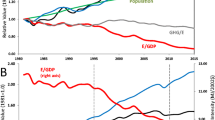Abstract
Rising energy use and energy-related global greenhouse gas emissions are encouraging new national energy efficiency policies and long-term international cooperative agreements. These require on-going studies to monitor their progress; thus, substantial effort must be directed toward developing reliable evaluation methodologies. One proposed methodology that is gaining in popularity involves energy efficiency indexes. The purpose of this paper is to show that there is a fundamental shortcoming in this approach that makes it unsuitable for estimating policy impacts. This is done in two ways: first, by comparing the calculation of a percent change in energy efficiency indexes to a conventional calculation of a percent change in the level of energy use and, second, by using a Monte Carlo experiment to estimate the probability that policy impacts estimated via an energy efficiency index, even one that has been adjusted, will contain a high degree of error.


Similar content being viewed by others
References
Ang, B. W., & Liu, N. A. (2007). Energy decomposition analysis: IEA model versus other methods. Energy Policy, 35, 1426–1432.
Ang, B. W., & Zhang, F. Q. (2000). A survey of index decomposition analysis in energy and environmental studies. Energy Economics, 25, 1149–1176.
Bali Action Plan (2007). The United Nations Climate Change Conference in Bali. Retrieved from http://unfccc.int/meetings/cop_13.
Bosseboeuf, D., Lapillonne, B., & Eichhammer, W. (2005). Measuring energy efficiency progress in the EU: The energy efficiency index ODEX. Proceedings of the 2005 European Council for an Energy Efficient Economy Summer Study, Stockholm, Sweden, pp. 1127–1135.
Boyd, G., & Laitner, J. A. (2001). Recent trends in the U.S. energy intensity: an index number analysis. International Association for Energy Economics Newsletter, 10(2), 4–9 “Skip”.
European Commission (2006) Directive 2006/32/EC of the European Parliament and of the Council of 5 April 2006 on energy end use efficiency and energy services (ESD). Official Journal of the European Union 27.4.2006, L 114/64.
Golove, W., & Schipper, L. (1997). Restraining carbon emissions: measuring energy use and efficiency in the USA. Energy Policy, 25(7–9), 803–812.
Herring, H. (2006). Confronting Jevons’ paradox: does promoting energy efficiency save energy. International Association for Energy Economics Newsletter, 15(4), 14–15.
Horowitz, M. J. (2007). Changes in electricity demand in the United States from the 1970s to 2003. The Energy Journal, 28(3), 93–119.
International Atomic Energy Agency (IAEA) (2005). Energy indicators for sustainable development: guidelines and methodology. Vienna, Austria: International Atomic Energy Agency.
Intelligent Energy Executive Agency (IEEA) (2007). Monitoring and evaluation: 5 innovative projects for an energy-intelligent Europe. Brussels, Belgium: European Commission.
National Energy Policy Development Group (NEPDG) (2001). National energy policy: Reliable, affordable, and environmentally sound energy for America’s future. Washington, DC: National Energy Policy Development Group.
Odyssee (2007). Retrieved from http://www.odyssee-indicators.org/Indicators/PDF/odex.pdf.
Ortiz, D., & Sollinger, J. (2003). Shaping our future by reducing energy intensity in the U.S. economy. Volume 1: Proceedings of the Conference, Prepared for the U. S. Department of Energy. CaliforniaRAND Science and Technology Policy Institute.
Rosenfeld, A. H. (2005). Extreme efficiency: Lessons from California. Sacramento, CA: California Energy Commission.
Schipper, L. & Haas, R. (Eds.) (1997). Cross-country comparisons of indicators of energy use, energy efficiency and CO2 emissions. Energy Policy, 25(7–9), 639–831.
Sun, J. W. (1999). Decomposition of aggregate CO2 emissions in the OECD: 1960–95. The Energy Journal, 20(3), 147–156.
Thomas, S. (2005). The quantitative targets for energy savings proposed by the draft directive on energy end-use efficiency and energy services—How to define, how to monitor them. Wuppertal, Germany: Wuppertal Institute for Climate, Environment, and Energy.
Thomas, S., Nilsson, L. J., Eichhammer, W., Vreuls, H., Broc, J.-S., Bosseboeuf, D. et al. (2007). How much energy savings is 1% per year. Evaluation and Monitoring for the EU Directive on Energy End-Use Efficiency and Energy Services (EMEEES). European Expert Workshop, ECEEE Summer Study, La Colle-sur-Loop, FR.
Tol, R. S. J., & Weyant, J. P. (2006). Energy economics most influential papers. Energy Economics, 28, 405–409.
Weisstein, E. W. (2007). Weak law of large numbers. From MathWorld—A Wolfram web resource. Retrieved from http://mathworld.wolfram.com/WeakLawOfLargeNumbers.
Zarnikau, J. (1999). A note: will tomorrow’s energy efficiency indices prove useful in economic studies. The Energy Journal, 20(3), 139–146.
Acknowledgment
This research was funded by the U.S. Environmental Protection Agency. The author would like to thank Barry Brent for his analytical contributions and helpful suggestions. The author takes sole responsiblity for all errors and opinions found within.
Author information
Authors and Affiliations
Corresponding author
Rights and permissions
About this article
Cite this article
Horowitz, M.J. The trouble with energy efficiency indexes: la aritmetic non e opinione. Energy Efficiency 1, 199–210 (2008). https://doi.org/10.1007/s12053-008-9015-9
Received:
Accepted:
Published:
Issue Date:
DOI: https://doi.org/10.1007/s12053-008-9015-9




